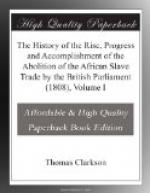The first division of the box consisted of woods of about four inches square, all polished. Among these were mahogany of five different sorts, tulip-wood, satin-wood, cam-wood, bar-wood, fustic, black and yellow ebony, palm-tree, mangrove, calabash, and date. There were seven woods of which the native names were remembered: three of these, Tumiah, Samain, and Jimlake, were of a yellow colour; Acajou was of a beautiful deep crimson; Bork and Quelle were apparently fit for cabinet work; and Benten was the wood of which the natives made their canoes. Of the various other woods the names had been forgotten, nor were they known in England at all. One of them was of a fine purple; and from two others, upon which the privy council had caused experiments to be made, a strong yellow, a deep orange, and a flesh-colour were extracted.
The second division included ivory and musk; four species of pepper, the long, the black, the Cayenne, and the Malaguetta: three species of gum; namely, Senegal, Copal, and ruber astringens; cinnamon, rice, tobacco, indigo, white and Nankin cotton, Guinea corn, and millet; three species of beans, of which two were used for food, and the other for dyeing orange; two species of tamarinds, one for food, and the other to give whiteness to the teeth; pulse, seeds, and fruits of various kinds, some of the latter of which Dr. Spaarman had pronounced, from a trial during his residence in Africa, to be peculiarly valuable as drugs.
The third division contained an African loom, and an African spindle with spun cotton round it; cloths of cotton of various kinds, made by the natives, some white, but others dyed by them of different colours, and others, in which they had interwoven European silk; cloths and bags made of grass, and fancifully coloured; ornaments made of the same materials; ropes made from a species of aloes, and others, remarkably strong, from grass and straw; fine string made from the fibres of the roots of trees; soap of two kinds, one of which was formed from an earthy substance; pipe-bowls made of clay, and of a brown red; one of these, which came from the village of Dakard, was beautifully ornamented by black devices burnt in, and was besides highly glazed; another, brought from Galam was made of earth, which was richly impregnated with little particles of gold; trinkets made by the natives from their own gold; knives and daggers made by them from our bar-iron; and various other articles, such as bags, sandals, dagger-cases, quivers, grisgris, all made of leather of their own manufacture, and dyed of various colours, and ingeniously sewed together.
The fourth division consisted of the thumb-screw, speculum oris, and chains and shackles of different kinds, collected at Liverpool. To these were added, iron neck-collars, and other instruments of punishment and confinement, used in the West Indies, and collected at other places. The instrument, also, by which Charles Horseler was mentioned to have been killed, in the former volume, was to be seen among these.




